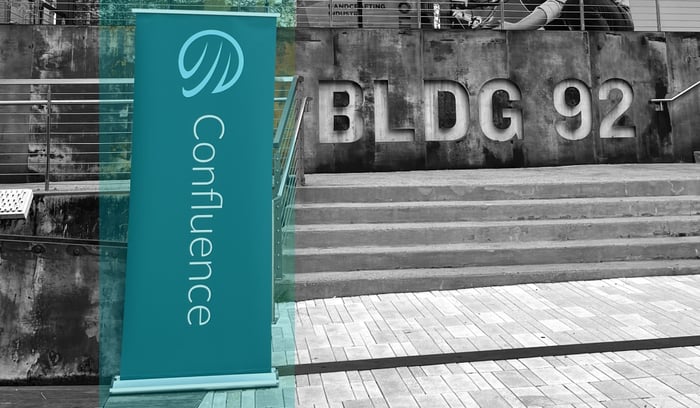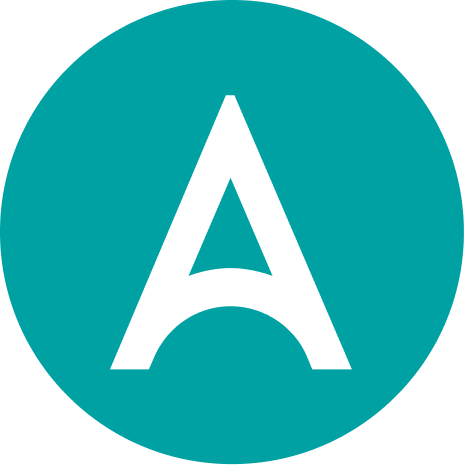
Our team at AVAIL hosted the first Confluence New York single-day event in the Brooklyn Navy Yard April 17, 2024, and we had such an amazing time learning from top architecture, engineering, and construction (AEC) industry firms Woods Bagot, SHoP Architects, Perkins&Will, and Thornton Tomasetti. The day’s sessions explored how these firms are using artificial intelligence (AI) and machine learning (ML) technologies to innovate and what that might mean for the industry as a whole. We’ve put together a quick summary and key takeaways from each presentation below. Our next event, Confluence Lexington, is September 12,13, and 14, 2024.
Quick Guide
- Woods Bagot: The Augmented and Empathetic Architect
- SHoP Architects: Interactive Visualization: Democratizing Access to the 3D Model
- Perkins&Will: AI in Practice
- CORE studio at Thornton Tomasetti: Engineering the AI Revolution
Woods Bagot: The Augmented and Empathetic Architect
 Kicking off the programming for the day, Principal and Director of Technical Innovation Shane Berger from global design studio Woods Bagot discussed the implications of AI in architecture. The technology is not meant to replace the entire profession, he noted, but to automate tasks and expand design ideas. Shane emphasized the importance of using AI as a tool to augment human intelligence and creativity, rather than relying solely on its capabilities.
Kicking off the programming for the day, Principal and Director of Technical Innovation Shane Berger from global design studio Woods Bagot discussed the implications of AI in architecture. The technology is not meant to replace the entire profession, he noted, but to automate tasks and expand design ideas. Shane emphasized the importance of using AI as a tool to augment human intelligence and creativity, rather than relying solely on its capabilities.
Key Takeaways for AEC Technology Leaders:
-
Don’t be afraid of technology: Embrace the opportunities of AI and ML, but also consider the limitations and balance what is built versus what is bought.
-
Build the right products: The number one failure in the software industry is building the wrong product, Shane said. Prioritize building tools that benefit the staff, investing in their skills, ideas, knowledge, and work-life balance. This leads to higher delivery efficiency and a well-rested, more capable staff.
-
Aim for openness: From a tools perspective, make sure the tools you invest in can work with other tools and are reconfigurable to project needs and workflows. Additionally, make sure you are fostering knowledge sharing in your team, creating safe spaces for exploration, and pushing project-level innovations to systemic-level change.
-
Emphasize augmentation: Use technology to prompt new ideas, improve design thinking, and enhance empathy in the design process.
SHoP Architects: Interactive Visualization: Democratizing Access to the 3D Model
 Next up, Interactive Visualization Associate Tim Li and IoT Engineer Designer Sheldon McLeod from architectural design firm SHoP Architects discussed how SHoP is using real-time visualization, augmented reality (AR), and virtual reality (VR) to enhance the design and construction process, as well as how AI and ML can further improve efficiency and productivity in the AEC industry. Their goal is to democratize access to 3D models and streamline the construction process by utilizing advanced technology and data analysis.
Next up, Interactive Visualization Associate Tim Li and IoT Engineer Designer Sheldon McLeod from architectural design firm SHoP Architects discussed how SHoP is using real-time visualization, augmented reality (AR), and virtual reality (VR) to enhance the design and construction process, as well as how AI and ML can further improve efficiency and productivity in the AEC industry. Their goal is to democratize access to 3D models and streamline the construction process by utilizing advanced technology and data analysis.
Key Takeaways for AEC Technology Leaders:
-
Embrace emerging technologies: AEC firms should actively explore and adopt emerging technologies such as AR, VR, real-time engines, and ML. These technologies can enhance design processes, improve communication with clients, and streamline construction administration.
-
Democratize access to 3D models: Find ways to make 3D models more accessible to all stakeholders involved in the construction process. This can include using AR for construction administration—what if the Department of Buildings could sign off on 3D models instead of traditional document-based representation?—and utilizing real-time tech for design reviews and visualization.
-
Experiment and innovate: AEC firms should create a culture of experimentation and innovation. Test new systems, technologies, and processes within the office. SHoP chooses to test in smaller projects to mitigate risks. They continuously seek new ways to add value to clients and improve the design and construction processes.
- Collaborate and integrate: Foster collaboration and integration between different technologies and systems. Ensure interoperability between different platforms and tools to create a seamless workflow. This includes integrating environmental sensors, human presence sensors, and other data sources into building models to provide a comprehensive view of the project.
Perkins&Will: AI in Practice
 After lunch, programming picked back up with Perkins&Will’s Charles Portelli and Nirvik Saha discussing their work on AI in practice. They talked about how they are using AI to standardize naming conventions in architectural projects, capture the expertise of designers, and generate images. It is important to be proactive in embracing AI in the industry, they noted, but also be sure to consider the ethical and confidentiality aspects of AI usage.
After lunch, programming picked back up with Perkins&Will’s Charles Portelli and Nirvik Saha discussing their work on AI in practice. They talked about how they are using AI to standardize naming conventions in architectural projects, capture the expertise of designers, and generate images. It is important to be proactive in embracing AI in the industry, they noted, but also be sure to consider the ethical and confidentiality aspects of AI usage.
Key Takeaways for AEC Technology Leaders:
- Evolve the profession: Instead of fearing the impact of AI on job roles, technology leaders should focus on how AI can evolve and enhance the architecture and construction professions. Be proactive and strive to be the drivers of change rather than passive passengers by actively seeking ways to disrupt and innovate within their own firms.
- Explore ways to add control and protection over AI generators: As important as it is to leverage this technology to evolve the profession, it is also imperative to protect client data and intellectual property. “How can we protect the data and security from these contractual agreements that we signed with our clients?” Charles asked. Directors of technology should be aware of the potential risks associated with AI models trained on publicly available data and user-provided information.
- Utilize AI to capture expertise: Technology leaders should explore ways to leverage AI to capture the expertise of experienced designers within their firms. Perkins&Will has harvested Revit data from 70 projects—understanding that this is the design output indicative of Perkins&Will’s collective design experience—and developed AI agents and algorithms to answer queries like, “how would you design this?”
- Leverage AI for efficient design processes: AI can be used to answer design-related queries, generate layouts, and assist with complex rules and regulations. Technology leaders should explore how AI can streamline design processes and provide valuable insights.
CORE studio at Thornton Tomasetti: Engineering the AI Revolution
 Closing our event, Thornton Tomasetti’s Seyedomid Sajedi, Senior AI/ML Engineer, and Sergey Pigach, Associate Applications Developer, gave a surprisingly emotional presentation about the AI and ML projects the firm’s CORE studio has been working on. After discussing the potential value of AI in the AEC and how Thornton Tomasetti is building its own AI, Seyedomid and Sergey shared a story about one of the team’s most valuable senior colleague’s recent passing and how they are using AI to preserve his knowledge.
Closing our event, Thornton Tomasetti’s Seyedomid Sajedi, Senior AI/ML Engineer, and Sergey Pigach, Associate Applications Developer, gave a surprisingly emotional presentation about the AI and ML projects the firm’s CORE studio has been working on. After discussing the potential value of AI in the AEC and how Thornton Tomasetti is building its own AI, Seyedomid and Sergey shared a story about one of the team’s most valuable senior colleague’s recent passing and how they are using AI to preserve his knowledge.
Key Takeaways for AEC Technology Leaders:
- Education is key: For the tools, it is important to learn from mistakes and gather feedback from engineers and industry professionals to improve AI applications. It is also crucial to educate people at all levels about what AI can and cannot do, how it works, and how it can be safely and productively implemented in the industry.
- Don’t sleep on synthetic data: Data is crucial for AI applications, but obtaining high-quality data can be challenging. CORE has invested in synthetic data generation, which they find to be a useful approach when real data is limited or difficult to retrieve.
- Stay organized with MLOps: Machine Learning Operations (MLOps) is important for managing and deploying ML models effectively. The team at Thornton Tomasetti has built their own MLOps platform that allows for better tracking, deployment, and management of models, ensuring transparency and efficiency.
- Using AI to preserve knowledge: As experienced professionals retire or leave the firm, AI can help preserve their knowledge and expertise, ensuring that valuable insights are not lost. Thornton Tomasetti recently lost the go-to person globally for everyone who had questions about welding or steel construction. “Mike mentored generations of TT engineers,” Seyedomid said. “It was very sad to see this person will not be among us anymore and his legacy will be lost.” Fortunately, he had shared a data set of over 10,000 email threads with the team, and CORE has been experimenting with a RAG pipeline to process this data and uphold his legacy for future TT engineers.


Intentionally programmed to give space for collaborative discourse, Confluence New York 2024 included discussions in small groups throughout the day and a social event at nearby Kings County Distillery afterwards.
More than just key takeaways from presentations, Confluence is a collection of the AEC industry’s most innovative minds. The event’s greatest value is the conversations between sessions with fellow leaders in this field. We intentionally build what we call “white space” into the schedule to foster these important conversations and hear over and over again that this is indeed guests’ favorite part.
Interested in joining us at the next Confluence event? AVAIL’s signature, invite-only Confluence Lexington conference will be held in September. Learn more about the three-day professional development event for leaders in the AEC industry and how you can be considered for an invite.
About Confluence
Hosted by software company AVAIL, Confluence is a series of architectural, engineering, and construction (AEC) industry professional development events that bring design technology and product management leaders together in collaborative discourse. Its signature conference is Confluence Lexington, which is a three-day, invite-only event held in the fall every year. In the last few years, regional, one-day events have also been added, as well as a podcast hosted by AVAIL CEO and Founder Randall Stevens and TRXL Podcast host Evan Troxel.





